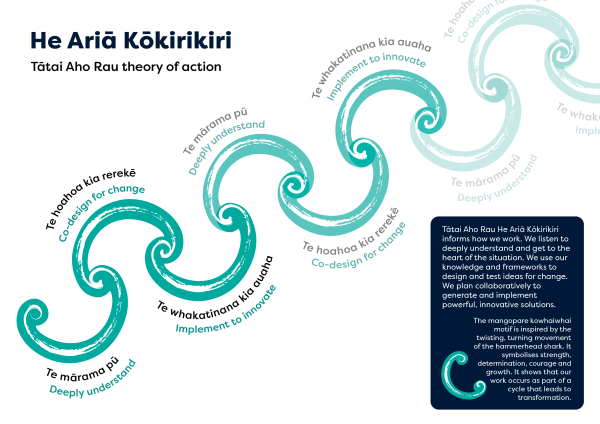Our ways
Our ways of working with you are shaped by our commitment to equity
Te Aho Tapu
Tātai Aho Rau Core Education has made a commitment to uphold and honour te Tiriti o Waitangi through an approach we call Te Aho Tapu.
It acts as a guide for our practices and interactions with each other, and our work with clients and partners. Te Aho Tapu gives us a lens through which to view everything we do. When we use a Te Aho Tapu lens we:
- acknowledge the significant place of Māori as tangata whenua in Aotearoa
- give effect to te Tiriti o Waitangi by ensuring te ao Māori perspectives are a part of the way we plan
- ensure decision-making processes result in equitable policy and action for Māori and non-Māori
- value te reo and tikanga Māori, and create the conditions in which these can be freely expressed
- recognise there is no one-size-fits-all model for partnership
- produce high-quality learning resources in English and te reo Māori.
We take collective responsibility and accountability for realising Te Aho Tapu and ensuring it remains at the centre of our efforts to fulfill our charitable purposes through our vision, mission and strategic goals.
We believe this approach will enable Tātai Aho Rau to contribute to an equitable and thriving Aotearoa through learning.
He Ariā Kōkirikiri and Universal Design for Learning
When you work with us, we will apply these two frameworks.
He Ariā Kōkirikiri, our theory of action, underpins our approach to co-design.
Universal Design for Learning ensures that all we do comes from an inclusive perspective.
He Ariā Kōkirikiri informs how we work in the facilitation space, we:
- listen to deeply understand and get to the heart of the situation
- use our knowledge and frameworks to design a PLD programme with you
- work collaboratively to implement innovative and sustainable change and build capability
- support the regular review and refining of the programme based on feedback and evolving needs
- work as part of a focused inquiry cycle that leads to transformation.
The mangopare kōwhaiwhai motif is inspired by the twisting, turning movement of the hammerhead shark. It symbolises strength, determination, courage and growth. It shows that our work occurs as part of a cycle that leads to transformation.

Tātai Aho Rau Core Education: Shaping our mahi
The concept of Tātai Aho Rau drives our professional practice and the endeavours it supports, including its awards and grants.
There are four binding threads to Tātai Aho Rau that shape our research and innovation:
- Whakapapa: Research and innovation connects ideas to practice.
- Tikanga: Research and innovation supports reciprocity and sustains links between people and organisations.
- Reo: Research and innovation is shared in ways and places where it can be used and sustained in practice.
- Wairua: Research and innovation is inclusive, encourages learning and critical reflection.
Tātai
Tātai is the act of weaving, blending one strand with the next to form connected patterns. Understanding the relationships of the strands within the weave is important in the completion of the final product.
At Tātai Aho Rau we place great value on the importance of connections. Knowing learning communities and educators within the different sectors we support is integral to the way we work.
Most important to us is knowing and understanding each other as individuals and as a collective. Diversity is our strength. Togetherness is also our strength.
Aho
When applied to weaving, aho are the threads that bind together. Within Tātai Aho Rau, aho relates to the threads that are common in all we do.
Rau
Rau is a leaf or harakeke blade. It also means ‘many’ and ‘multitudes’.
Harakeke symbolises the whānau, with the rito (child) in the centre, mātua (parents) encircling the young leaf, and the kaumātua (grandparents) represented in the outer leaves of the plant. A well-established harakeke bush is made up of a number of these family groups.
In our organisation we are naturally drawn to the many groupings within Tātai Aho Rau and the connections each group has with others. We understand that a single harakeke plant can stand alone, but it needs the support of the wider pā harakeke to thrive.
Lalaga Tivaevae Niu
Lalaga
Lalaga is the weaving of fibres, layering one strand over the next to create patterns. The term “lalaga” also symbolises the historical and reciprocal relationships between Pasifika nations.
Understanding the relationships of the strands within the weave is important to the pattern and textures. At Tātai Aho Rau the essence of our business is to arrange, prioritise, study connections, measure importance, and maximise relationships in positive ways that provide the support that best suits our clients. We are open to continuous and life-long learning and we are reflective in our approach.
Tivaevae
Tivaevae is the traditional Cook Islands art of quilt making. They are created for and given as gifts on special occasions and to celebrate important milestones. At Tātai Aho Rau the tivaevae symbolises our linking together the elements of teaching and learning to nurture our clients. As the pieces of tivaevae are stitched together by the group, so we at Tātai Aho Rau stitch together the elements of support we provide.
Niu
Niu means coconut and conveys its multiple dimensions as well as its nourishing qualities. Niu refers to the tree as well as to the coconut fruit itself. The tree is often referred to as the “tree of life”. Niu produce products for making cooking oil, rope, fish nets, and soap. The flesh and juice of the niu are eaten, and the shell of the niu is used as a dish or a cup for ceremonial purposes. Many Pasifika nations have myths and legends surrounding the creation story of the niu.
Niu can be applied as a symbol to the many groups within Tātai Aho Rau. The strength of Tātai Aho Rau is in the many groups within the company and their connections and relationships.